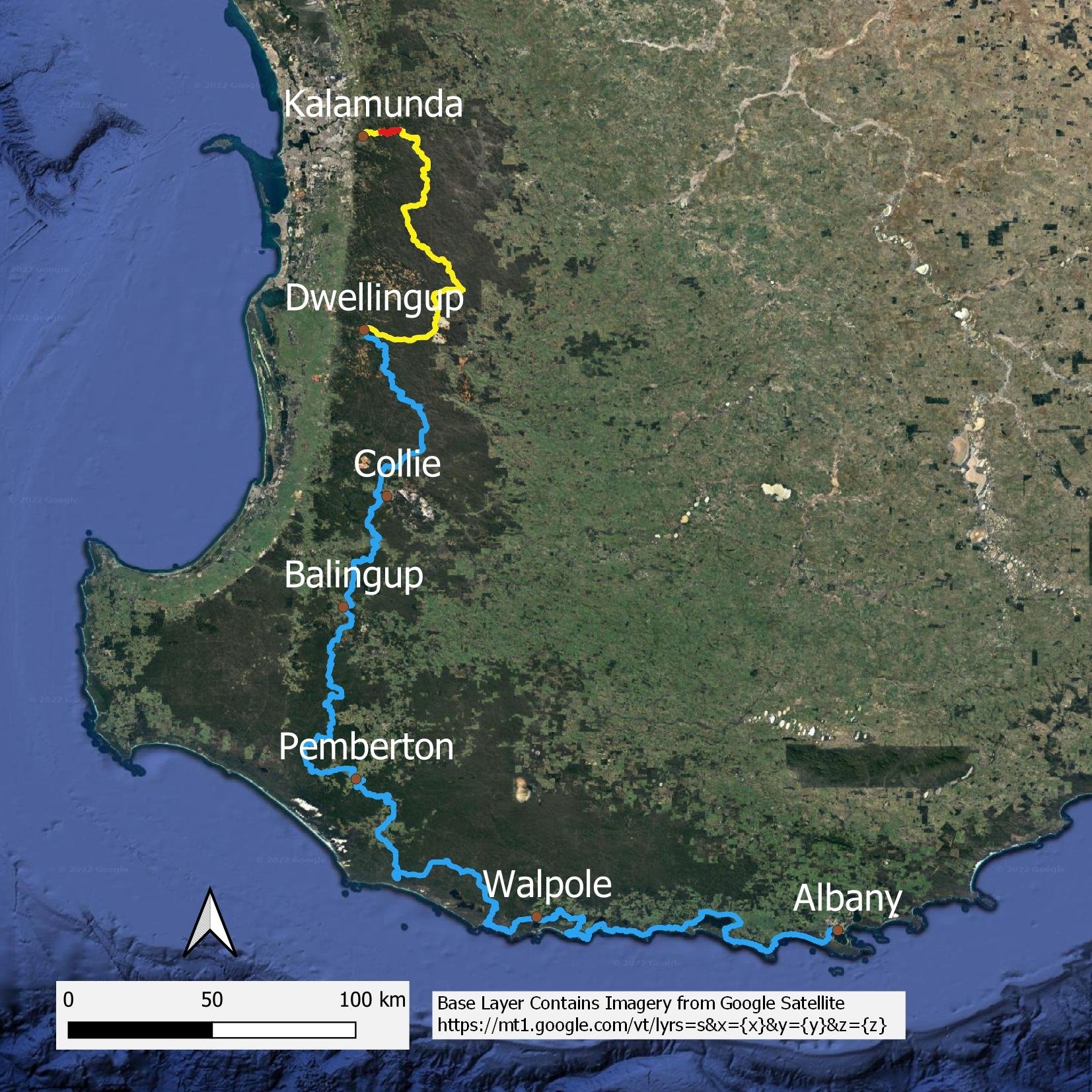Day 2: Hewett’s Hill to Ball Creek
We acknowledge the Nyoongar People as the traditional custodians of the land and waters along the Bibbulmun Track
A lovely leisurely distance today of just 10.6 km, but the 345 m (1130 ft) ascent is demanding. It’s quite showery, so not too many photos - which means we have plenty of time for an extra leisurely lunch!
Whilst there are many showers today in the short periods of sun, the forests again are colourful, and the rain makes the bush smell wonderfully fresh.
The forest walking is all about black trunks, red laterite, granite slabs and boulders, all perfumed with grevillea, plus sweet but weedy freesias in the towns and settlements. Well-graded tracks and surfaces again today, with parrots and birdsong overhead despite the rain. Just one triple-hutting hiker speeds past us, and we share the hut with our leisurely companions instead. It is their first ever multiday hike, and they are E2Eing! Amazing!
Sometimes the best highlights of the day are the most unexpected. We aren’t even aware of the Mundaring Weir Hotel… but we reach it conveniently around lunchtime AND IT IS OPEN! Yay! They also have accommodation for those who want an even shorter day.
It’s wet again, but the cheerful wildflowers lift our mood. The bright yellows against the dark sky are stunning.
Every now and then the forest opens up.
There are a lot of different sundews (Drosera) here. They exude a sticky liquid that traps insects. Here, there’s also rain on them.
More donkey orchids
Diuris porrifolia, Small-flowered Donkey Orchid
The first white spider of the hike! Caladenia longicauda ssp longicauda. There are quite a few different species and subspecies. Advice for IDing them: “Sit down with the Hoffmann [book] for a few hours!” I haven’t brought any books on the trip because the best ones are too heavy.
And another new Caladenia, C. macrostylis. You can see why it’s called the ‘Leaping Spider,’ shouting, “Look at me! Here I am!”
Every now and then we reach an edge of granite, and the glimpses we’ve had between the trees become vistas. We usually pop across to the edge for the views when there are breaks like this, one reason why we like to take our time.
The Darling Plateau is pretty amazing. One viewpoint has this sign. At 2,500 MILLION years old, the granite here is some of the most ancient on earth.
We walk along old disused forestry tracks. This is always nice as we can be side by side. Some people prefer single track; so far it’s been mainly the latter. But these forestry tracks are small and quiet.
The number and variety of pea flowers is astonishing.
I imagine readers are already beginning to understand why we are Slower Hikers. Geoff is happy to simply absorb the landscape, whereas I’m a details person!
And more sundews of every size and shape.
As we near Mundaring Weir, we see massive boulders in a sea of Hypocalymma angustifolia and wattle.
Because we didn’t read the guidebooks or pay much attention to the map here, we go the long way round down and along the bottom of the weir. Wasted altitude! But the old smoke stack is pretty cool!
Lemon scented Myrtle (Darwina citriodora) – it’s so much fun seeing plants growing in the wild that you normally only see in nurseries or botanic gardens!
But what’s this? We had no idea of the Mundaring Pub’s existence but hey, grab every opportunity that presents! There’s a cosy fire inside and it’s lunchtime, a win for leisurely hikers who will arrive at exactly the right time. A HUGE spread of nachos and beef pot pie as the rain hammers down outside. Yum!
There are few images from this afternoon because it pretty much rains the rest of the day. We stay surprisingly dry in our lightweight jackets. So far, I’m impressed. We reach the hut in good time because it’s been too wet to photograph flowers! However, when we arrive, I scout for tent sites and find these orchids growing right beside one: Pterostylis orbiculata
Ball Creek Hut is, rather unsurprisingly, in a little valley that’s a bit dank and gloomy in this weather. It’s great to get under shelter for that hot cuppa.
When the rain eases momentarily, we pitch the tent in a little flat spot right beside the road. Many of the campsites are low in the drainage line on bare dirt that doesn’t look ideal in this weather. You will end up in a pond. Unfortunately, many people have carefully raked the tent pads clear not only of twigs and gravel, but also of leaves. You can expect a lot of mud and splashback in heavy rain.
Despite the rain, it has been another good day of hiking. The terrain is not spectacular, but it is very beautiful. The best analogy might be the difference between the North and South islands of New Zealand, or plains instead of mountains. If the rest of the walk is as lovely as this, we are in for a treat.





















